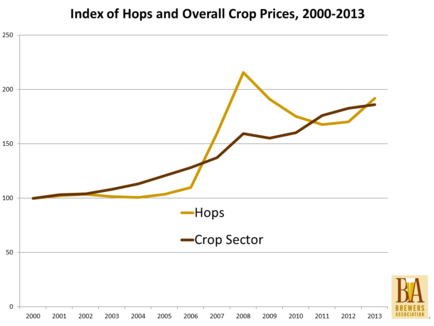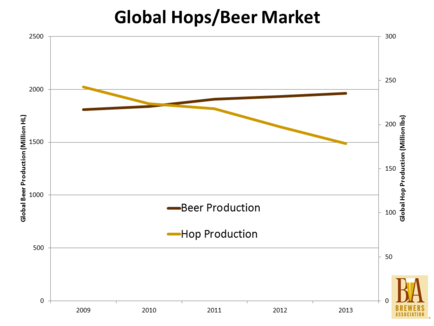The craft beer story du jour is about how America’s insatiable love of IPAs and the craft brewers who brew them is driving up the price of hops.
Now, I have no issue with the idea that craft is changing the US/global hops market. By some accounts, craft brewers now use 40-50% of all of the hops produced domestically. In addition, the shift in planted acres from alpha toward aroma has been a sight to see, and is certainly being driven by the rise in craft (which uses far higher levels of aroma hops). That said, I think the media may have been a wee bit hasty in putting the rise in hops prices solely at the feet of craft brewers.
The reason I say this is two-fold. First, the prices for hops are pretty much in line with the US crop sector generally (prices to growers, dealer markups may change this). The graph below shows an index of hops prices and the crop sector from 2000 to 2013 (USDA/NASS data, 2000=100). Since that point, hops prices have gone up 92%. General crop sector prices? 86%. Like all farmers, hop growers have to deal with rising energy prices, labor costs and other inputs. Those input costs in turn get passed on to customers.

Secondly, hops are a global commodity. This means that American craft brewers are only one small part of a much larger global marketplace, which increasingly includes a lot of new brewers in other countries. Furthermore, the dynamics of the global hop market are exactly those which you would expect to drive up hops prices, with growing beer production (i.e. increased demand for hops) and decreased supply (data from Hop Growers of America, 2013). Increased demand + decreased supply = increased prices… that’s about as simple an economics problem as you’ll ever get.

These trends are occurring at a time when US brewers are competing with a growing number of global brewers for US hops, which are increasingly popular outside the US.
If anything, there are several factors which suggest the rise in hops prices has been relatively modest. Some of these stem directly or indirectly from craft brewing. Some are simply changes in the industry. They all go beyond the simplistic, “people like IPAs”. They include:
- The shift from alpha acres planted to aroma acres planted. Aroma hops are much more costly than alpha hops (due to lower yields), and now typically fall between $7 and $10 a pound (2-7 times higher than alpha hops, with that variation based on variety, quality, scale, etc.). This shift, from less to more expensive hops, would alone account for a great deal of the increase in hops prices.
- A more segmented hop market as the number of hop varieties has increased. Increased segmentation means decreased scale. Decreased scale means increased cost.
- The rise of proprietary hops. Proprietary hops are varieties controlled by a company, which can control who grows it and drive up prices (similar to the way drug companies control drug prices to recoup investment).
- The more fragmented brewing industry, which means there is less scale buying than in the past. Again, decreased scale means increased cost.
- The rise in hop acres. The current global demand for US hops means that growers are in structural growth mode. Investment in new acres means new costs, including (in increasing order of costs): putting in root stock and stringing it; putting in new trellises in idle dirt; buying new acres (or tearing out other crops, such as apple orchards).
In sum, the idea that US craft brewers are the sole cause of a rise in hop prices misses a few key facts:
- Hop prices for growers are in line with other crops (this does not mean that final prices to brewers are in line due to dealer markups)
- Hops are traded globally, and US craft brewers as a group are still a small player in the global beer market
- There are lots of other reasons (other than IPAs) that hop prices have risen






 Resource Hub
Resource Hub